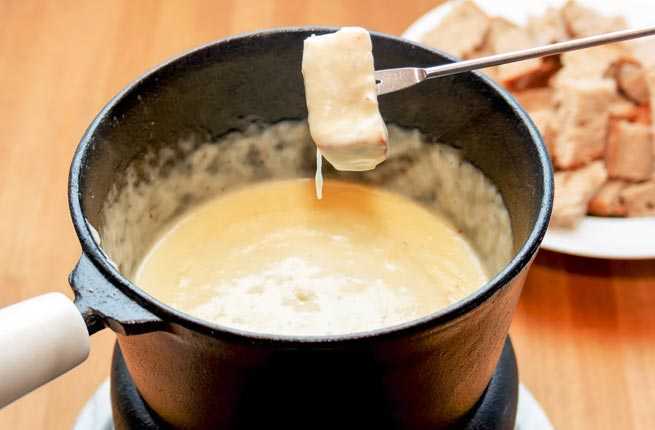While Swiss cheese has become a generic
term, there are actually several
different tasty types of Switzerland-made cheese that deserve your
attention.
Emmental (EM-mawn-tall) is one of the world's classic cheeses. It's the Swiss cheese
that all other Swiss cheeses are patterned after.
Emmental cheese (also called Emmentaler or Emmenthal) can trace its history back to the 13th century when it was first made in the Emme Valley, which is west of Lake Constance. Today Emmental is made in many parts of Switzerland.
Herds of cows, particularly the Brown Swiss breed, were lead from pastures in the valleys up to alpine meadows during the summer months. The cowherds would start near the pasture in the spring and work their way up the mountain as the snow melted. This let the cows eat fresh grass while the valley pastures grew hay for the cows to eat during winter.
This relatively
short grazing season in the mountains means a short milking season,
so making cheese in alpine meadows was a way to store this milk. The
wildflowers and grass of the alpine meadows are a factor in the
flavor of this cheese.
Chalets were built
at various points along the path so that cheese could be made without
having to haul the milk down the valley, and the wheels were made
very large, maybe a meter in diameter, so that it would keep better.
How Emmental is made
Emmental
is made from unpasteurized, partially skimmed milk from cow's that
are only fed grass and hay. These cows are not allowed to be fed
silage, a method of storing grass that involves fermentation. Modern
production of Emmental is year round and during winter, when the cows
are fed hay, the milk is a paler yellow and the cheeses are often
smaller.
Salt
is heavy to haul up a mountain, so salt is used sparingly and heat
and pressure are used to remove moisture from the curds. The curds
are cut into tiny pieces and heated in a vat to expel whey before they pressed into a mold.
Emmental is made in very large , flat sided wheels that can weigh up to 200 pounds. The rind is thin, hard, and brownish yellow. The interior is pale yellow-ivory and will be pock-marked with holes.
The holes in Swiss cheese are called “eyes,” and they are formed by one of the three types of bacteria used to make Emmenthal. Two of the bacteria create lactic acid, which is consumed by the third type of bacteria, Propionibacterium shermanii. In addition to producing compounds that flavor the cheese, P. shermani also releases carbon dioxide which causes bubbles that become the eyes. Emmenthal eyes are large, about the size of cherries and walnuts.
Historically, these eyes were seen as an imperfection and cheesemakers would try to remove them by continued pressing of the cheese. Now the large eyes have become a visual trademark of Emmental.
Emmental is different than Swiss cheese from the deli.
The rind is marked with a label and a dairy number, then the wheel is aged for 6 to 18 months. After 8 months the cheese is mature, and after 12 months it is fully mature. After 8 months the cheese is aged in a damp cellar and the rind may darken. Avoid any cheese if the rind has turned grey.
Emmental will change your mind about Swiss cheese.
The
cooking and pressing of the curds, and the minimal use of salt,
yields a cheese that is pliable and tastes slightly nutty. The cheese is smooth and dense, with
sweet, nutty, fruity, and some brown butter flavors. When you
taste Emmental, you should be able to get a sense of the meadow
flowers and fresh grass.
Gruyère has a deeper, more complex flavor than Emmental because it is made with whole cow’s milk (not skimmed) and is aged longer. Gruyère has no holes.
If you are going to make a fondue, shred your cheese rather than cube it before melting it. It will be easier to shred if the cheese is cold. Melt the cheese soon after shredding it, as Emmental tends to dry out quickly, and melt it over low heat, as high heat may turn your cheese rubbery.
Wine & Beer Pairing
For a wine paring, I love Chasselas
with Emmental. Chasselas is a crisp white wine from Switzerland with plenty of acidity to
cut through the cheese between bites. Chasselas is a little
wine-geeky and may be hard to find, so if you can't find it, don't worry! Try pairing Emmental with Riesling or Viognier, which pair well for totally different reasons.
Riesling, either dry or off-dry, has a freshness and crispness that works well with this cheese. I love Reisling from Washington state. I also like German Reisling, but in this case I'd look for one that is relatively young, as aged German Reisling develops flavors that don't match as well with the fresh alpine meadow aspect of Emmental.
Riesling, either dry or off-dry, has a freshness and crispness that works well with this cheese. I love Reisling from Washington state. I also like German Reisling, but in this case I'd look for one that is relatively young, as aged German Reisling develops flavors that don't match as well with the fresh alpine meadow aspect of Emmental.
Viognier, doesn't have the same crispness that Riesling does, but it has aromas will bring out the alpine meadow aspect
of the cheese. This is the same reason that hard cider will also pair
well with Emmental.
Are you a beer
drinker? The clove aromas of a German style hefeweizen will be a
nice counterpoint to the nutty flavors of the cheese. Try Emmental with a Bock or Oktoberfest Beer. The maltiness of the beer will
also play off of the cheese's nuttiness.







No comments:
Post a Comment